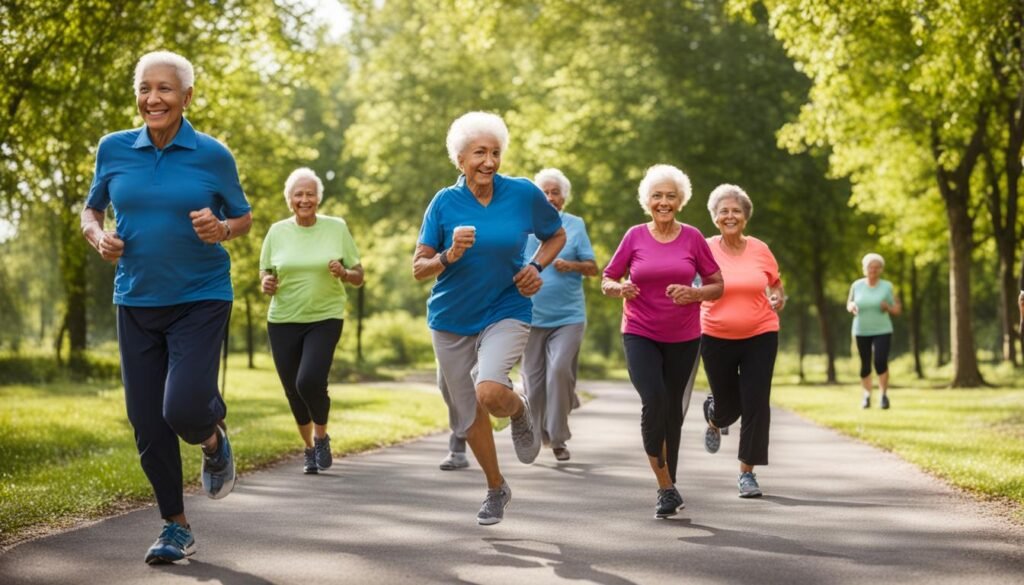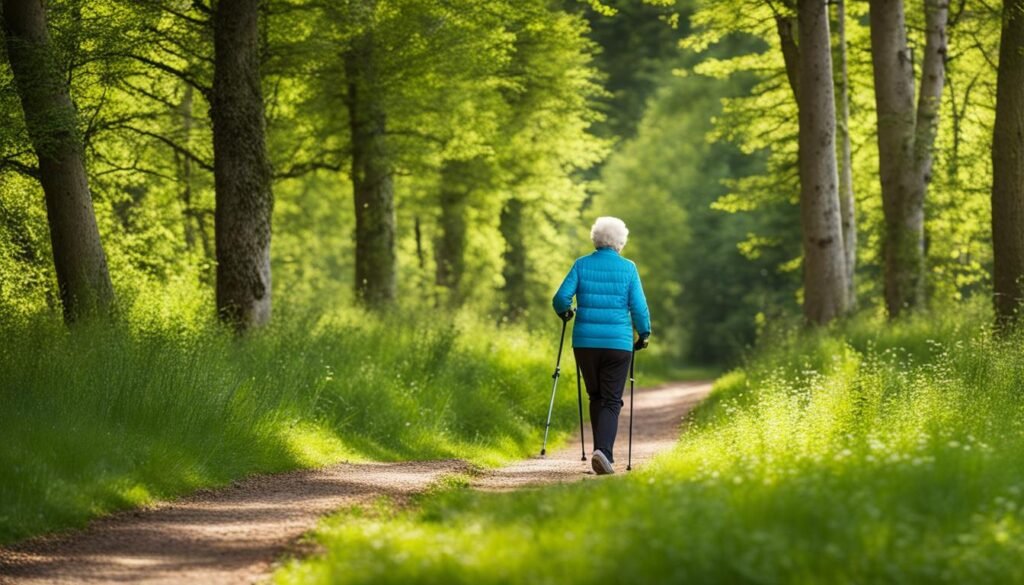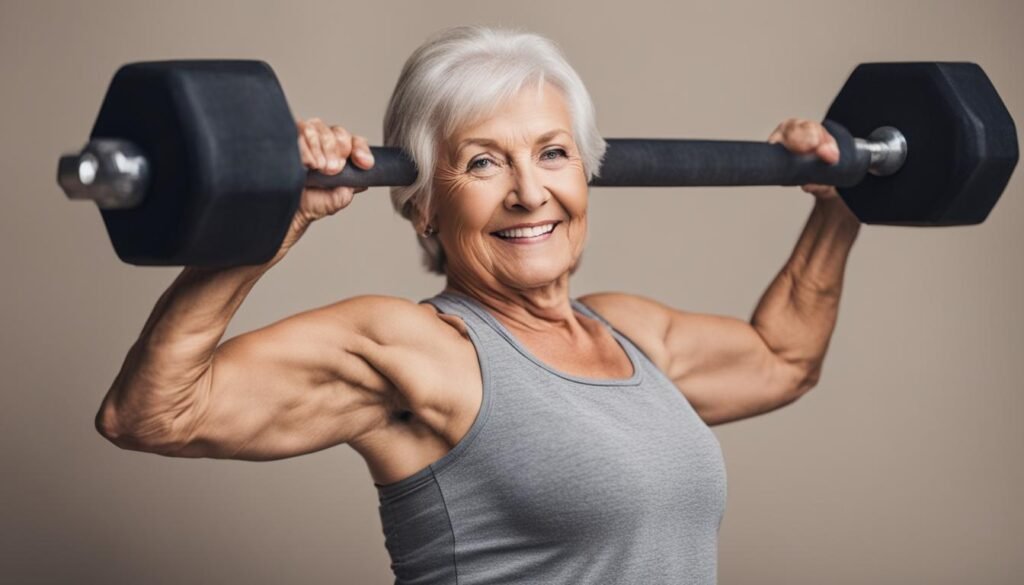As you age, maintaining an active lifestyle becomes increasingly important for your overall health and well-being. Research shows that physical activity is the number one contributor to longevity, regardless of when you start exercising. Regular exercise can help you maintain or lose weight, reduce the impact of chronic diseases, enhance mobility and balance, improve sleep and mood, boost brain function, and prevent memory loss and cognitive decline. It’s never too late to incorporate simple, enjoyable ways to become more active and reap the numerous benefits of exercise.
Key Takeaways:
- Regular exercise is crucial for the health and well-being of seniors
- Exercise can help with weight management, disease prevention, mobility, and balance improvement
- Physical activity has positive effects on sleep, mood, brain function, and cognitive abilities
- It’s never too late to start incorporating exercise into your routine
- Seek professional guidance and tailor exercise routines based on your fitness levels and health conditions
Benefits of Exercise for Older Adults
Regular exercise offers a multitude of benefits for older adults. It can help maintain a healthy weight by increasing metabolism and building muscle mass. Exercise also improves immune and digestive functioning, blood pressure, bone density, and reduces the risk of various chronic diseases such as Alzheimer’s, diabetes, obesity, heart disease, osteoporosis, and certain cancers. Additionally, exercise improves strength, mobility, flexibility, and balance, reducing the risk of falls and alleviating symptoms of chronic conditions like arthritis. It also promotes quality sleep, boosts mood and self-confidence, and enhances brain function, memory, and cognitive abilities.
As we age, staying active becomes even more crucial for maintaining overall health and well-being. Physical activity contributes significantly to longevity, regardless of when you start exercising. Incorporating simple, enjoyable ways to become more active can have numerous positive effects on your body and mind. Whether it’s a regular walking routine, swimming, dancing, or participating in senior fitness classes, staying physically active in your older years can significantly improve your quality of life.
Table: Benefits of Exercise for Older Adults
| Benefits | Description |
|---|---|
| Weight management | Exercise helps maintain a healthy weight by increasing metabolism and building muscle mass. |
| Disease prevention | Regular physical activity reduces the risk of chronic diseases such as Alzheimer’s, diabetes, obesity, heart disease, osteoporosis, and certain cancers. |
| Mobility and balance improvement | Exercise enhances strength, mobility, flexibility, and balance, reducing the risk of falls and improving overall physical function. |
| Better sleep | Physical activity promotes quality sleep, helping you rest and recharge for optimal well-being. |
| Enhanced mood and cognitive function | Exercise boosts mood, self-confidence, brain function, memory, and cognitive abilities, improving mental well-being and overall cognitive function. |
It’s important to note that before starting any exercise program, it’s recommended to consult with your healthcare provider, especially if you have any underlying health conditions or concerns. They can provide personalized guidance and recommendations based on your individual needs and abilities. Remember, it’s never too late to start exercising and reap the numerous benefits it offers for your physical and mental well-being.
Overcoming Exercise Myths for Older Adults
Exercise and aging have been the subject of many misconceptions. It’s time to debunk these myths and provide clarity on age-related exercise limitations. One common myth is that it’s too late to start exercising as you get older. In reality, it’s never too late to begin a fitness routine. Regular physical activity can benefit individuals of all ages, including seniors. It can improve health, prevent falls, and even enhance athletic ability.
Another myth is that exercise is unsafe for older adults. While it’s important to consider individual fitness levels and health conditions, exercise can be done safely and should be tailored to meet each person’s needs. Consulting with healthcare professionals and seeking guidance from certified trainers can ensure a safe and effective exercise program.
“The only limit to your exercise routine is your mindset. Don’t let age be a barrier. Embrace the benefits of exercise and focus on what you can do, rather than what you can’t.”
Lastly, there is a misconception that aging automatically means a decline in physical function. While certain physical changes may occur with age, regular exercise can help mitigate these effects. Exercise can improve strength, flexibility, and balance, reducing the risk of falls and promoting overall physical function and independence. By staying active and incorporating appropriate exercises into their routine, older adults can maintain a high quality of life.
Avoiding Common Exercise Myths
When it comes to exercise, it’s essential to separate fact from fiction. Here are some key points to remember:
- It’s never too late to start exercising. Regardless of age, there are exercise options available for everyone.
- Exercise is safe for older adults, but it’s important to consider individual needs and consult with professionals for guidance.
- Physical changes associated with aging can be mitigated through regular exercise.
- Focus on what you can do and find enjoyable ways to stay active.
| Exercise Myths for Seniors | Debunking Exercise Misconceptions | Age-Related Exercise Limitations |
|---|---|---|
| Myth: It’s too late to start exercising in old age. | Fact: It’s never too late to start exercising. Age should not be a barrier to physical activity. | Fact: Regular exercise can benefit individuals of all ages, including seniors. It can improve health, prevent falls, and enhance athletic ability. |
| Myth: Exercise is unsafe for older adults. | Fact: Exercise can be done safely and should be tailored to individual fitness levels and health conditions. | Fact: Consulting with healthcare professionals and seeking guidance from certified trainers can ensure a safe and effective exercise program. |
| Myth: Aging means a decline in physical function. | Fact: Regular exercise can improve strength, flexibility, and balance, promoting overall physical function and independence. | Fact: Physical changes associated with aging can be mitigated through regular exercise. |
Types of Exercise for Older Adults
When it comes to staying active in your golden years, there are various types of exercises that are beneficial for older adults. Incorporating a combination of these exercises into your routine will help you maintain your overall fitness and improve your quality of life. Here are the four main types of exercises that are recommended for seniors:
Balance Exercises:
Balance exercises are crucial for older adults as they help improve stability and reduce the risk of falls. Activities such as yoga and tai chi are excellent choices for enhancing balance and coordination. These exercises focus on strengthening the muscles in your legs and core, which are essential for maintaining stability and preventing accidents.
Cardiovascular (Aerobic) Exercises:
Engaging in cardiovascular exercises is important for improving heart health and overall endurance. Activities like walking, swimming, and biking are great options for seniors. Regular aerobic exercise helps strengthen your heart and lungs, improves circulation, and boosts energy levels, ensuring that you stay healthy and active as you age.
Strength Training:
Strength training exercises are essential for maintaining muscle mass and bone density, which tend to decline with age. Incorporating resistance training, using weights or resistance bands, into your routine helps build strength, balance, and stability. It also improves overall joint health and reduces the risk of injuries, enabling you to perform daily activities with ease.
Flexibility Workouts:
Flexibility exercises, such as stretching and yoga, are crucial for older adults to maintain joint mobility and prevent stiffness. These exercises help improve flexibility, reduce muscle tension, and enhance overall range of motion. Flexibility workouts also promote relaxation and stress reduction, contributing to your overall well-being.
Seniors can benefit from joining specialized senior fitness classes that cater to their unique needs and abilities. These classes provide a supportive environment, with instructors who are trained to work with older adults. They offer a variety of exercises that target different areas of fitness, ensuring a well-rounded and enjoyable workout experience.

| Exercise Type | Benefits |
|---|---|
| Balance Exercises | Improve stability and reduce the risk of falls |
| Cardiovascular (Aerobic) Exercises | Enhance heart health and overall endurance |
| Strength Training | Maintain muscle mass, improve bone density, and enhance balance |
| Flexibility Workouts | Promote joint mobility, reduce stiffness, and prevent injuries |
Starting an Exercise Routine
Starting or maintaining an exercise routine can be challenging at any age, but it’s particularly important for seniors. It’s crucial to start slowly and gradually increase the intensity and duration of exercise. This helps prevent injuries and allows the body to adapt to physical activity. It’s also essential to choose activities that are enjoyable and suit individual preferences and abilities. Finding an exercise buddy, seeking professional guidance, and incorporating physical activity into daily routines can all help make exercise a regular and sustainable habit.
Tips for Getting Active as a Senior
- Start with low-impact activities: Begin your exercise routine with low-impact activities that are gentle on your joints, such as walking, swimming, or cycling. Gradually increase the intensity and duration as your fitness level improves.
- Choose activities you enjoy: Find activities that you enjoy doing, whether it’s dancing, gardening, or playing a sport. This will make exercising more enjoyable and increase your motivation to stick with it.
- Set realistic goals: Set realistic goals that are achievable for you. Start with small milestones and celebrate your progress along the way. Remember, every little bit counts.
- Stay consistent: Consistency is key when it comes to exercise. Try to incorporate physical activity into your daily routine, whether it’s taking the stairs instead of the elevator or going for a walk after dinner.
- Listen to your body: Pay attention to how your body feels during and after exercise. If you experience pain or discomfort, modify or stop the activity. It’s important to prioritize your safety and well-being.
Remember, starting an exercise routine in your 70s is a journey, not a sprint. Be patient with yourself and celebrate every step you take towards a healthier and more active lifestyle.
Aerobic Activity for Older Adults

Aerobic activity, also known as cardiovascular exercise, is crucial for maintaining a healthy heart and overall fitness. It involves activities that increase heart rate and breathing, such as walking, hiking, biking, dancing, and swimming. Older adults should aim for at least 150 minutes of moderate-intensity aerobic exercise, such as brisk walking or fast dancing, each week. They can also opt for vigorous-intensity activities like running or cycling for at least 75 minutes per week. It’s important to start at a comfortable level and gradually increase the intensity and duration of aerobic activity.
Aerobic exercise offers numerous benefits for older adults. It improves cardiovascular health by strengthening the heart and increasing blood circulation. Regular aerobic activity helps lower blood pressure, reduce the risk of heart disease, and improve overall endurance. It also aids in weight management by burning calories and boosting metabolism. Additionally, aerobic exercise promotes lung capacity and oxygen intake, enhancing respiratory function.
Engaging in aerobic activity has a positive impact on mental well-being as well. It releases endorphins, the feel-good hormones, which can help reduce stress, anxiety, and symptoms of depression. Aerobic exercise also improves cognitive function, memory, and concentration, contributing to better brain health as we age.
Incorporating Strength Training and Flexibility Exercises
Strength training and flexibility exercises are essential components of a well-rounded exercise routine for seniors. These types of exercises help improve muscle strength, bone density, balance, and flexibility, promoting overall physical function and independence. Here are some key benefits of incorporating strength training and flexibility exercises into your fitness regimen:
- Improved Muscle Strength: Strength training exercises, such as lifting weights or using resistance bands, can help build and maintain muscle mass. This is particularly important for seniors, as age-related muscle loss can lead to weakness and a higher risk of falls.
- Enhanced Bone Density: Strength training not only strengthens muscles but also stimulates bone growth. This can help prevent osteoporosis and reduce the risk of fractures, which are more common in older adults.
- Better Balance and Stability: Balance exercises, which often involve strengthening the core and lower body muscles, can significantly improve stability and reduce the risk of falls. Activities like yoga and tai chi are particularly beneficial for improving balance and coordination.
- Increased Flexibility: Flexibility exercises, such as stretching and yoga poses, help improve joint mobility and reduce stiffness. This can enhance overall flexibility and range of motion, making daily activities easier and more comfortable.
When incorporating strength training and flexibility exercises into your routine, it’s important to start gradually and listen to your body. Begin with lighter weights or resistance and gradually increase the intensity over time. It’s also important to practice proper form and technique to avoid injury. If you’re new to strength training, consider working with a personal trainer or joining a fitness class specifically designed for seniors.
“Strength training and flexibility exercises play a crucial role in maintaining functional abilities and promoting active aging in older adults. These exercises not only improve physical performance but also enhance quality of life and overall well-being.”
Remember to prioritize consistency in your exercise routine. Aim to incorporate strength training exercises at least two days a week, with a day of rest in between sessions to allow for muscle recovery. Flexibility exercises, on the other hand, can be performed daily or incorporated into your warm-up and cool-down routines.
By including strength training and flexibility exercises in your fitness routine, you can enjoy the numerous benefits they offer, such as improved muscle strength, increased bone density, enhanced balance and stability, and greater flexibility. So, get started today and make these exercises an essential part of your active and healthy lifestyle!

Conclusion
Staying active and maintaining a regular exercise routine is crucial for seniors to enjoy a healthy and fulfilling life. Exercise offers numerous benefits for older adults, including weight management, disease prevention, improved mobility and balance, better sleep, enhanced mood and cognitive function, and overall improved well-being. It’s never too late to start incorporating exercise into your daily routine and reap the rewards of active aging.
With the right mindset, realistic goals, and guidance from healthcare professionals, seniors can find enjoyable and suitable ways to stay fit and active in old age. Whether it’s walking, swimming, strength training, or practicing yoga, there are plenty of options to choose from. Remember, age should never be a barrier to pursuing a vibrant and active lifestyle. Prioritize your health and well-being, and embark on this journey of active aging with confidence and determination.
So, don’t wait any longer. Take the first step towards a healthier and more active lifestyle. Start by incorporating small changes into your daily routine, such as taking a brisk walk or joining a senior fitness class. The key is to find activities that you enjoy and that suit your abilities. Stay committed, stay consistent, and embrace the benefits of exercise for seniors. With dedication and perseverance, you can age gracefully while staying fit and active.
FAQ
What are the benefits of exercise for older adults?
Regular exercise offers a multitude of benefits for older adults, including weight management, disease prevention, improved mobility and balance, better sleep, enhanced mood and cognitive function, and overall improved well-being.
Can seniors start exercising even if they have never done it before?
Absolutely! It’s never too late to start exercising. Regardless of age or physical condition, everyone can find enjoyable ways to become more active and improve their overall health.
What are the different types of exercise recommended for older adults?
There are four main types of exercise that are important for older adults: balance exercises, cardiovascular (aerobic) exercises, strength training, and flexibility workouts. These exercises help improve stability, heart health, muscle mass, and joint mobility, respectively.
How should seniors start an exercise routine?
It’s crucial for seniors to start slowly and gradually increase the intensity and duration of exercise. Additionally, choosing activities that are enjoyable and suit individual preferences and abilities, finding an exercise buddy, seeking professional guidance, and incorporating physical activity into daily routines can all help make exercise a regular and sustainable habit.
How much aerobic activity should older adults aim for?
Older adults should aim for at least 150 minutes of moderate-intensity aerobic exercise, such as brisk walking or fast dancing, each week. Alternatively, they can opt for vigorous-intensity activities like running or cycling for at least 75 minutes per week.
Are strength training and flexibility exercises recommended for older adults?
Yes, strength training and flexibility exercises are highly recommended for older adults. Strength training helps preserve muscle mass, improve bone density, and enhance balance and stability. Flexibility exercises improve joint mobility and reduce stiffness, helping to prevent injuries.
Why is it important for seniors to maintain an exercise routine?
Staying active and maintaining a regular exercise routine is vital for seniors to enjoy a healthy and fulfilling life. Exercise offers numerous benefits, including weight management, disease prevention, mobility and balance improvement, better sleep, enhanced mood and cognitive function, and overall improved well-being.
How Does Prioritizing Mental Health Impact Staying Fit and Active in Your 70s?
Prioritizing mental health in older adults is crucial for staying fit and active in your 70s. Taking care of your mental well-being can contribute to better physical health by reducing stress and anxiety, improving sleep, and boosting overall mood. Engaging in activities like meditation, socializing, and pursuing hobbies can enhance mental wellness and consequently enhance physical fitness in the golden years.

